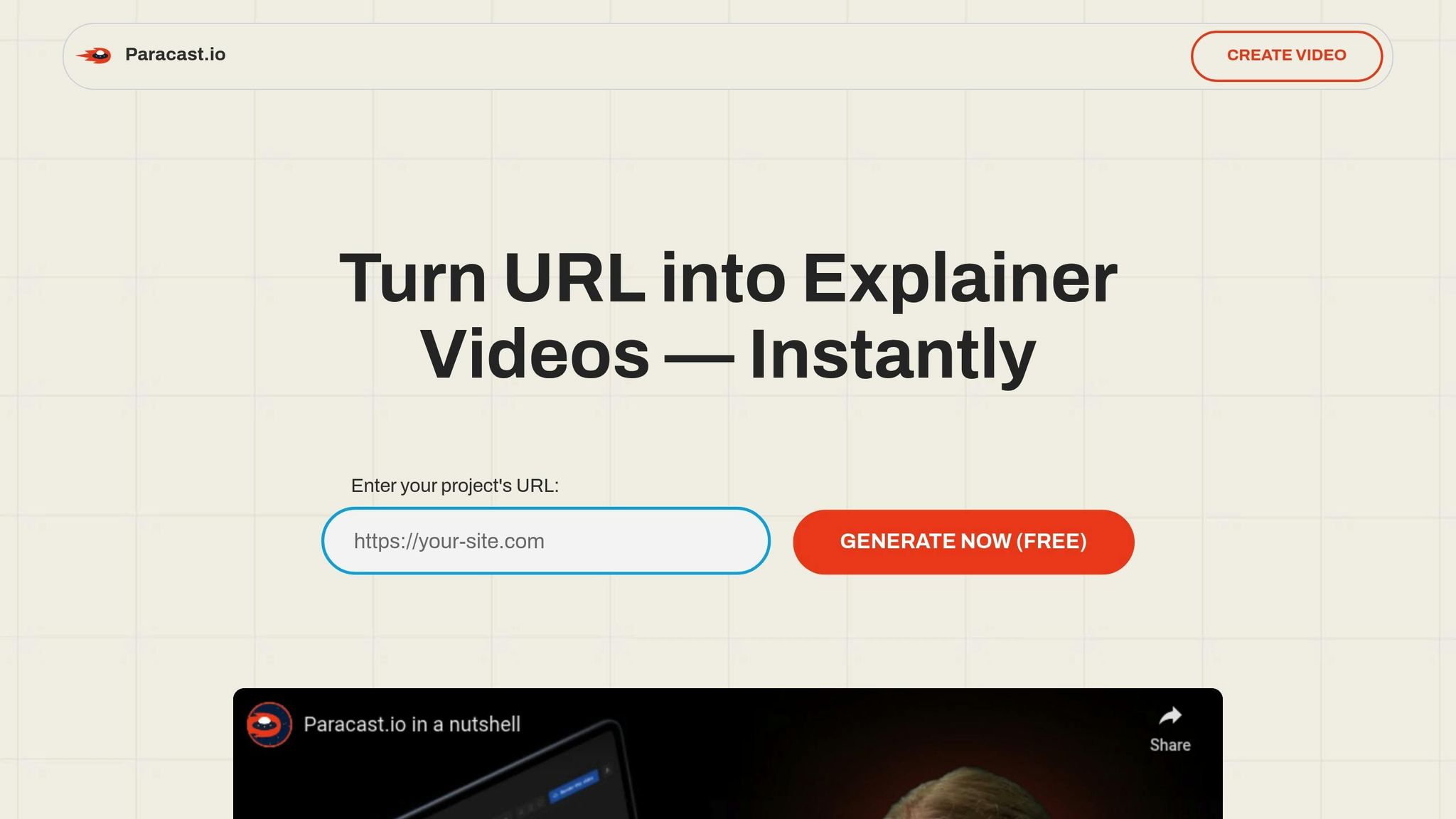Want your videos to generate more leads? Start by including effective CTAs (Call to Actions). A well-placed CTA can guide viewers to take the next step - like signing up for a trial or downloading a resource - turning passive viewers into active leads.
Here’s what you need to know:
- Tools Matter: Platforms like Paracast.io simplify adding CTAs with AI-powered video creation, pre-made templates, and easy customization options.
- Placement is Key: Early in the video grabs attention, mid-video engages peak interest, and end-of-video works for trust-building.
- Design for Clicks: Use bold colors, clear text, and mobile-friendly sizes to make CTAs stand out.
- Test and Optimize: A/B test colors, text, timing, and placement to improve performance.
Track metrics like click-through rates and conversions to refine your strategy. With the right tools and approach, your videos can become powerful lead-generation assets.
Make More Money and Get More Leads with This CTA Strategy (Call-to-action Masterclass) #CallToAction
Choosing the Right Tool for Adding CTAs
When it comes to adding calls to action (CTAs) in your videos, the tool you choose should strike a balance between being easy to use and offering robust functionality. The ideal platform will let you create polished, professional videos while giving you the freedom to customize CTAs without needing advanced technical skills.
Look for features like AI-powered video generation, pre-made templates, customizable branding options, and 1080p video output - all without requiring complicated integrations.
For startups, agencies, freelancers, or small teams, the best tools combine powerful capabilities with a user-friendly interface. This means you can produce engaging videos with effective CTAs that drive results, without relying on a dedicated video production team. A smooth and efficient production process also ensures your CTAs are well-designed and strategically placed to convert viewers into leads.
Key Features of Paracast.io for CTA Integration

Paracast.io is a web-based platform designed to make creating promotional videos fast and easy. Using AI, it can generate videos directly from a website URL, so you don’t have to start from scratch or manually upload extra materials.
The platform includes pre-made templates tailored to a variety of business needs, such as product demos, feature announcements, partnership launches, milestone celebrations, hiring updates, funding news, and special promotions. These templates are designed to align with different stages of the customer journey, making it simpler to match your CTAs to your goals.
With customizable branding, you can ensure your videos stay consistent with your brand’s look and feel. Options to adjust colors, fonts, and visual elements help build trust and familiarity with your audience. Additionally, Paracast.io offers unlimited video creation and downloads, so you can experiment with different CTA styles without worrying about usage limits.
The platform’s intuitive editing tools make it easy to tweak templates, adjust timing, and customize CTAs - even if you’re not a video production expert. This means you can achieve professional-quality results without needing to master complex software or hire outside help.
With these features in mind, let’s break down the process of adding CTAs step by step.
How to Add CTAs with Paracast.io
Once you’ve chosen Paracast.io, here’s how to effectively integrate CTAs into your videos:
- Start by entering your website URL. The platform’s AI will analyze your content and recommend the best template based on your campaign goals. For example, if you’re introducing a new feature, you might select the feature announcement template. For lead generation, a product demo or special offer template is ideal for embedding strong CTAs.
- The platform will then generate an initial video based on your website’s content, organizing it within the selected template. This automated process saves you significant time compared to creating videos entirely from scratch.
- Next, refine the video by customizing the messaging, visuals, and placement of your CTAs. Whether you want a subtle “Learn More” prompt or a bold “Start Free Trial” button, the editing tools allow you to test different styles for maximum impact.
- Finally, export your completed video. Since Paracast.io offers unlimited downloads, you can create multiple versions for A/B testing or repurpose them across social media, email campaigns, landing pages, and other marketing channels where you aim to capture leads.
The entire process is quick and efficient, making it an excellent option for teams that need to produce high-quality video content regularly without large-scale production resources.
Best Practices for CTA Placement and Design
When you’re creating videos with Paracast.io, optimizing your Call-to-Action (CTA) placement and design is key to turning viewers into leads. Let’s dive into how to strategically position and design CTAs for better results.
Where to Place CTAs in Videos
The placement and timing of your CTAs should match your goals and how your audience interacts with your content. Each option has its strengths, depending on what you aim to achieve.
Early placement (within the first 10-15 seconds) is ideal for grabbing the attention of viewers who already know your brand or are highly motivated to act. This approach works well for urgent offers but can come across as too aggressive if your audience isn’t familiar with your product or service.
Mid-video CTAs take advantage of peak engagement moments. Research shows that viewers are most engaged around the 30-45 second mark in promotional videos. This is a great time to introduce your offer, but it’s important to ensure the CTA fits naturally within the content and doesn’t disrupt the flow.
End-of-video placement works best for educational content or product demos where you need time to build trust and establish value. While this approach allows you to make a strong case before asking for action, it does have a downside - many viewers may drop off before reaching the end.
Overlay CTAs are clickable elements that appear on top of your video at any point. They’re effective for capturing attention without interrupting the video, but they need to be carefully designed to avoid covering important visuals.
| Placement | Best For | Pros | Cons |
|---|---|---|---|
| Early (0-15 seconds) | Familiar audiences, urgent offers | Captures attention quickly | May feel pushy to new viewers |
| Mid-video (30-45 seconds) | Highlighting features, product demos | Utilizes peak engagement | Needs seamless integration |
| End-of-video (final 10 seconds) | Educational or trust-building content | Builds value before asking for action | Risk of high viewer drop-off |
| Overlay (any time) | Social media, short videos | Non-intrusive, flexible timing | Can block key visuals |
Designing CTAs That Get Clicks
The design of your CTA can make or break its performance. Here are some tips to create CTAs that drive clicks:
- Use attention-grabbing colors. Colors like orange, red, or bright green tend to perform better because they stand out. However, make sure the color complements your overall design while still contrasting with your brand’s palette.
- Choose the right size and shape. CTAs should be large enough to be easily clickable, especially on mobile devices. Apple’s accessibility guidelines recommend a size of at least 44x44 pixels. Rounded buttons often feel inviting, while rectangular ones can convey urgency or authority.
- Keep the text clear and action-oriented. Use short, direct phrases like “Get Started Now” or “See It in Action.” Avoid generic terms like “Click Here.” Stick to 2-5 words for maximum readability.
- Add subtle animations. A gentle pulse or fade-in effect can draw attention to your CTA without being distracting. Avoid excessive animations like blinking or bouncing, which can seem unprofessional and may cause issues for users with sensory sensitivities.
- Prioritize accessibility. Ensure your CTA meets accessibility standards by using sufficient color contrast (at least a 4.5:1 ratio for text), adding alternative text for screen readers, and ensuring functionality for keyboard navigation.
Once you’ve nailed the design, it’s time to refine your CTAs using A/B testing.
Using A/B Testing for CTA Optimization
A/B testing allows you to fine-tune your CTAs based on real data, eliminating guesswork. To get meaningful results, focus on testing one element at a time.
- Test colors. Experiment with different CTA colors to see which gets the most clicks. Keep all other elements the same to isolate the impact of color. Run each test for about a week or until you have at least 1,000 views per variation.
- Experiment with text. Try different action words (e.g., “Start” vs. “Get”), urgency levels (e.g., “Now” vs. no urgency), and messaging styles (e.g., benefit-focused vs. action-focused). Small changes can reveal what resonates most with your audience.
- Adjust placement timing. Test CTAs at different points in your video to see what works best. For example, compare click-through rates for CTAs placed early, mid-video, or at the end. Sometimes, giving viewers more time to engage with your content can improve overall performance.
- Play with size and positioning. Test larger versus smaller CTAs, different screen positions (e.g., bottom-right vs. center), and whether overlay or integrated designs work better. Track not only clicks but also viewer feedback and how the design impacts your brand perception.
- Measure multiple metrics. Beyond clicks, monitor video completion rates, time-to-click, cost per lead, and actual conversions. A CTA with fewer clicks might still generate better-quality leads who are more likely to convert.
Before starting, set up a clear testing framework. Define your goals, determine the minimum sample size, and establish how long each test will run. Most tests need 2-3 weeks to account for viewing patterns and seasonal trends.
sbb-itb-5bfa442
Step-by-Step Guide to Adding CTAs to Videos
Here’s how you can effectively add CTAs to your videos using Paracast.io.
Setting Your Lead Generation Goals
Before diving into video creation, take a moment to define what success looks like for your campaign. Your lead generation goals will guide every decision about your CTA’s design and placement.
Start by pinpointing a single, measurable goal. What specific action do you want viewers to take? Whether it’s signing up for a demo, downloading a resource, or starting a free trial, be crystal clear about the desired outcome. This clarity ensures your CTA has a focused purpose.
Next, think about the value you’re offering in exchange for the viewer’s action. Is it exclusive content, a free trial, a discount, or actionable insights? Your CTA should clearly communicate this value to make it enticing. For example, if you’re offering a free trial, highlight what makes it worth their time.
Finally, set measurable targets. For instance, aim to increase email sign-ups by 20% or generate 50 demo requests. These benchmarks not only help you track progress but also refine your CTAs over time. With clear goals in place, you’re ready to customize your CTAs using Paracast.io.
Customizing CTAs with Paracast.io
Paracast.io makes it easy to integrate CTAs into your videos with its user-friendly templates. These templates are designed for a variety of purposes, whether you’re creating product demos, announcements, or promotional content - each tailored to support different lead generation goals.
When starting a new project, choose a template that matches your campaign’s objective. Then, craft your CTA text using action-oriented language that sparks urgency and highlights the benefit. Instead of generic phrases like "Click Here", try something more engaging, such as "Start Your Free Trial" or "Access the Guide Now."
You can also tweak visual elements to make your CTA stand out while staying on-brand. Adjust colors, fonts, and button sizes, using contrasting hues to grab attention without disrupting your video’s overall aesthetic.
Timing and placement are equally important. Paracast.io lets you decide exactly when and where your CTA appears in the video. Additionally, you can link your CTA directly to a relevant landing page. Make sure the messaging aligns - if your CTA says "Download the Marketing Guide", the landing page should immediately provide access to that guide.
Publishing and Testing Video CTAs
Once your CTA is customized, it’s time to publish and test your video across platforms. Export it in the appropriate format for each channel - whether it’s for social media, email campaigns, or your website - to ensure it looks polished and professional everywhere.
Strategically deploy your video across key touchpoints. You can feature it on your website’s homepage, include it in email marketing campaigns, share it on platforms like LinkedIn or X (formerly Twitter), or even use it in sales presentations. While the core video and CTA should remain consistent, you can make small tweaks to suit each platform.
Before launching your campaign, test everything thoroughly. Click through your CTA to confirm it leads to the correct landing page and that the user experience is seamless. Also, check that your video loads quickly and displays properly on both desktop and mobile devices.
Once live, keep a close eye on performance. Monitor metrics like click-through rates, video completions, and conversions. Go beyond surface-level data - track the quality of leads, conversion rates from lead to customer, and overall ROI. This ongoing analysis will help you fine-tune your CTAs for even better results.
Measuring and Improving CTA Performance
Once your video CTAs are live, tracking their performance is essential. The insights you gather will reveal what’s working and what needs tweaking, helping you fine-tune your approach and generate more leads over time. By focusing on specific metrics, you can make targeted adjustments that enhance lead generation.
Key Metrics for Tracking CTAs
Click-Through Rate (CTR) is a key measure of how effective your CTA is. It shows the percentage of viewers who click on your CTA compared to the total number of video impressions [6–9]. A solid CTR means your CTA’s wording, placement, and timing are resonating with your audience.
Conversion Rate goes a step further, tracking the percentage of users who complete the desired action - whether that’s signing up for a demo, downloading a resource, or starting a free trial - after clicking the CTA [6–9]. While CTR gauges initial interest, conversion rate indicates how well your landing page delivers on the promise of the CTA.
Video Completion Rate gives you a sense of how much of your video viewers are watching before they leave [7–9]. If viewers drop off before reaching your CTA, you’re missing potential conversions. High completion rates suggest your content is engaging enough to keep viewers watching until the call-to-action.
Play Rate measures how many page visitors actually start watching your video. This metric offers insights into whether your video’s thumbnail, title, and placement are compelling enough to get people to hit play [7,9].
Other valuable metrics include engagement indicators and watch time, which show how invested viewers are in your content. Additionally, tracking bounce rate and time on page for users who click your CTA can reveal whether your landing page aligns with the CTA’s promise. A high bounce rate might indicate a disconnect between the two.
By analyzing these metrics, you can continuously refine your CTA design and placement to improve results.
How to Improve CTA Performance
Start by digging into your data to uncover trends. Tools like Google Analytics can help you track how CTAs perform across different traffic sources and audience segments [10,12]. Look for patterns: when viewers are most likely to click, which videos drive the most conversions, and where users drop off in your funnel.
"Effectively analyzing call-to-action (CTA) performance is essential in driving conversions."
- Aidan Eaton, Wit Group Agency
Use A/B testing to experiment with different elements of your CTAs. Test variations in text, color, size, and placement, and make sure you set clear goals and sample sizes for each test [10,12].
Personalization can significantly improve results. Research shows that personalized CTAs convert 202% better than generic ones. With tools like Paracast.io, you can create tailored video versions with customized CTAs for different audience segments.
Heatmap analysis and session recordings can also pinpoint friction points. If viewers are skipping over your CTA, consider adjusting its size, position, or timing [10,12].
"However, testing and analytics are crucial to refining what works best for your audience."
- Microsoft Clarity Blog
Timing is another critical factor. If your data shows viewers dropping off before your CTA appears, try moving it earlier in the video. For longer videos, adding multiple CTAs at different points can help capture interest at various stages.
Make sure your landing page matches your CTA’s promise. For instance, if your CTA says, "Get Your Free Marketing Audit", the landing page should immediately deliver on that promise, not redirect users to a generic contact form.
Finally, experiment with different CTA placements - at the beginning, middle, or end of your video - to see what works best. Implement changes gradually so you can pinpoint which adjustments are driving better results while keeping successful elements intact.
Conclusion
Every element of your video - whether it's the tools you use or how you design your CTAs - plays a crucial role in turning viewers into leads. Without effective CTAs, even the most captivating video content can become a missed opportunity.
The real magic lies in strategic placement and thoughtful design. Your CTAs should appear at just the right moments, feature persuasive language, and stand out visually without interrupting the viewing experience. Whether you place them at the start to grab attention, in the middle when engagement peaks, or at the end when viewers are primed to act, timing is everything.
Paracast.io makes this process seamless by offering AI-powered video creation tools with built-in CTA functionality. With just your website URL, the platform can generate professional videos with tailored CTAs. Its pre-designed templates for product demos, announcements, and social media content ensure your branding stays consistent while boosting conversions.
Optimization is an ongoing process. Keep an eye on key metrics like click-through rates, conversion rates, and video completions to identify what’s working and improve what’s not. Experiment with A/B testing, tailor CTAs to specific audience segments, and study viewer behavior to refine your strategy. Use the data to make informed adjustments that enhance performance over time.
Strong CTAs act as a bridge between your video content and your business objectives. When viewers click, they should land on a page that delivers exactly what you’ve promised. This alignment between your video, CTA, and landing page builds trust and transforms casual viewers into loyal customers. By creating meaningful connections and guiding your audience toward clear next steps, you can turn engagement into real results.
FAQs
What’s the best way to place CTAs in videos to boost engagement and drive conversions?
To get the most out of your videos, placing your CTAs (calls-to-action) strategically based on viewer behavior and content flow is key. Mid-roll CTAs tend to perform well because they show up when viewers are most engaged, often boosting conversion rates. If you’re promoting something time-sensitive, pre-roll CTAs at the very start of the video can grab attention right away. On the other hand, post-roll CTAs work well for viewers who stick around until the end, giving you a chance to connect with your most invested audience.
You can also use multiple CTAs throughout the video to appeal to different audience segments. The best approach? Test different placements and keep an eye on the results to see what resonates most with your viewers.
What are the best ways to design CTAs in videos to grab attention and drive action?
To create CTAs that grab attention, focus on making them straightforward, brief, and action-oriented. Use commanding verbs like “Sign Up Now” or “Learn More” to direct your audience clearly. Combine this with language that highlights benefits or stirs emotion to make the action irresistible.
From a design perspective, your CTA should be impossible to miss. Use bold colors, strong contrasts, and buttons or text sized appropriately for any screen. Placing CTAs in strategic spots - like at the end of a video or during impactful moments - can boost engagement. And don’t forget: CTAs must be mobile-friendly to ensure a smooth experience and encourage clicks on any device.
How can I use A/B testing to improve the effectiveness of CTAs in my videos?
A/B testing is a smart way to improve how well your video CTAs perform. The idea is simple: create two versions of your video, each with a small tweak to the call-to-action (CTA). For example, you could change the wording, placement, size, or color of the CTA. Then, share these versions with different audience groups and monitor key metrics like click-through rates, engagement levels, and conversions.
Once you've got the data, you can compare the performance of each version to see which approach connects best with your audience. This method gives you clear insights into what works and helps you optimize your videos to drive more leads and make your CTAs as impactful as possible.


